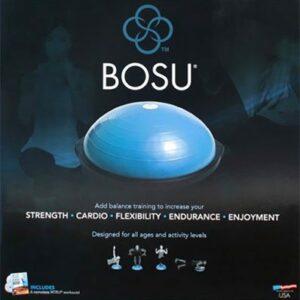Femoral Neck Fracture
Updated:
(Also known as Fractured Neck of Femur)
What is a femoral neck fracture?
A femoral neck fracture is a condition characterized by a break in the neck of the femur (thigh bone).
The femur is the anatomical name given to the long bone of the thigh (figure 1). It is the largest and strongest bone in the body. The neck of the femur refers to the part of the bone which connects the round headed ball of the hip joint to the long shaft of the femur.
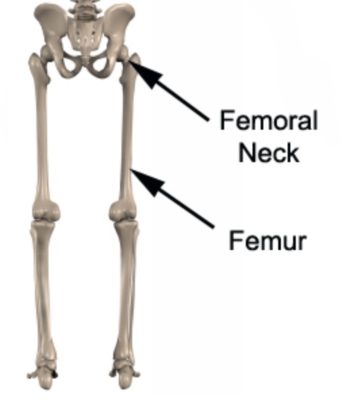
Following a fall or due to a direct blow to the hip or thigh, stress is placed on the femur. If these forces are excessive and beyond what the femur can withstand, a break in the neck of the bone may occur. When this occurs the condition is known as a femoral neck fracture and can vary from a small undisplaced fracture to a severe displaced (and / or comminuted) fracture with obvious deformity.
Femoral neck fractures are particularly common in elderly patients who have poor balance (i.e. are prone to falls) and have reduced bone density due to osteoporosis.
Cause of a femoral neck fracture
Due to the strength of the femoral bone, a femoral neck fracture usually requires a large amount of force in healthy young adults. This typically occurs due to a fall (usually from a height, and often onto a hard surface) or due to a direct blow to the femur such as a motor vehicle accident. The most common clinical presentation of a femoral neck fracture is in older patients (greater than 60) who have weakened bones due to conditions such as osteoporosis, or sometimes, malignancy. In these cases, the injury may occur with minimal force such as a trip, stumble or fall.
Signs and symptoms of a femoral neck fracture
Patients with a femoral neck fracture typically experience a sudden onset of sharp, intense pain in the hip, groin, buttock or thigh at the time of injury. In severe cases, particularly involving a displaced fracture of the femur, weight bearing will be impossible with the patient often unable to get up off the floor without help. In less severe cases, patients may be able to walk (typically with a limp) and may experience symptoms that settle quickly with rest, leaving the patient with an ache at the site of injury which may be particularly prominent at night or first thing in the morning. Occasionally patients may also experience symptoms in the lower back, knee, lower leg, ankle or foot.
Patients with a femoral neck fracture may also experience swelling, bruising and pain on firmly touching the hip region. Pain usually increases with certain movements of the hip or knee, when sitting or when attempting to stand or walk (particularly up hills or on uneven surfaces). Often the patient’s leg will present in a “turned-out” position and will appear to be shorter compared to the unaffected leg. In severe femoral fractures (with bony displacement), an obvious deformity may be noticeable. Occasionally patients may also experience pins and needles or numbness in the hip, groin, thigh, knee, lower leg, ankle or foot.
Diagnosis of a femoral neck fracture
A thorough subjective and objective examination from a physiotherapist is essential to assist with diagnosis of a femoral neck fracture. An X-ray is usually required to confirm diagnosis and assess the severity. Further investigations such as an MRI, CT scan or bone scan may be required, in some cases, to assist with diagnosis and assess the severity of the injury.
Treatment for a femoral neck fracture
For those femoral neck fractures that are displaced (which is usually the most common presentation), treatment typically involves anatomical reduction (i.e. re-alignment of the fracture via careful manipulation under anaesthetic) followed by surgical internal fixation to stabilize the fracture (using rods, plates, pins or screws). This may be followed by a period of rest and the use of walking aids or crutches for a number of weeks. In elderly patients (particularly those with osteoarthritis affecting the hip joint), prosthetic replacement of the hip joint may be indicated. This may be followed by the use of crutches or a walking frame for weeks to months.
For those less common, non-displaced fractures, treatment may involve the use of crutches and/or bed rest for a number of weeks. The orthopaedic specialist will advise the patient as to which management is most appropriate based on a number of factors, including the location, severity and type of femoral neck fracture.
For those patients who are not managed with hip joint replacement, evaluation of the fracture with follow up X-rays is important to ensure the fracture is healing in an ideal position. This is particularly important as blood supply to the femoral head may be damaged during a fracture resulting in significant complications with fracture healing (e.g. delayed healing, non-healing or death of the femoral head due to lack of blood supply, known as avascular necrosis). Once healing is confirmed, rehabilitation and mobilisation can progress as guided by the orthopaedic surgeon and the treating physiotherapist.
One of the most important components of rehabilitation following a femoral neck fracture is that the patient progresses their rehabilitation with exercises and activities which do not increase their pain (crutches are often required). Activities which place large amounts of stress through the femur should also be avoided, particularly excessive weight bearing activities such as running, jumping, standing or walking excessively (especially up hills or on uneven surfaces), lifting or carrying, or, sitting excessively. Rest from aggravating activities allows the healing process to take place in the absence of further damage. Once the patient can perform these activities pain free, a gradual return to these activities is indicated provided there is no increase in symptoms. This should take place over a period of weeks to months with direction from the treating physiotherapist.
Ignoring symptoms or adopting a ‘no pain, no gain’ attitude is likely to cause further damage and may slow healing or prevent healing of the femoral neck fracture altogether.
Patients with a fractured femur should perform pain free flexibility, strengthening and balance exercises as part of their rehabilitation to ensure an optimal outcome. This is particularly important, as balance, soft tissue flexibility and strength are quickly lost with inactivity. Hydrotherapy exercises are also often indicated. The treating physiotherapist can advise which exercises are most appropriate for the patient and when they should be commenced.
In the stages following confirmation of fracture healing, manual “hands-on” treatment from a physiotherapist, such as massage, trigger point release techniques, dry needling, joint mobilisation, stretches and electrotherapy, can assist with improving range of movement, pain and function, and assist with hastening return to activity.
In the final stages of rehabilitation for a femoral neck fracture, a gradual return to activity can occur as guided by the treating physiotherapist provided there is no increase in symptoms. In younger patients, this may involve a gradual return to running program followed by acceleration, deceleration and change of direction drills, before commencing training and eventually match play.
Prognosis of a femoral neck fracture
Most patients with a non-displaced femoral neck fracture make a full recovery with appropriate management. Patients with a displaced femoral neck fracture that requires surgical internal fixation or hip joint replacement are unlikely to return to high level sporting activity. Depending on the severity of the fracture (and the type of activity), return to activity or some sports usually occurs between 3-12 months. This should be guided by the treating physiotherapist and specialist. In patients with severe injuries involving structural deformity or damage to other bones, soft tissue, nerves or blood vessels, recovery time may be significantly prolonged.
Physiotherapy for a femoral neck fracture
Physiotherapy treatment is vital in all patients with a femoral neck fracture to hasten healing and ensure an optimal outcome. Treatment may comprise:
- soft tissue massage
- joint mobilization
- electrotherapy (e.g. ultrasound)
- dry needling
- the use of crutches, walking frames or other gait aids
- exercises to improve strength, flexibility, core stability and balance
- hydrotherapy
- education
- activity modification advice
- a graduated return to running / activity plan
- footwear advice
Other intervention for a femoral neck fracture
Despite appropriate physiotherapy and surgical management, some patients with a femoral neck fracture do not improve adequately and may require other intervention (this may also be required in patients who experience some of the common complications of a femoral neck fracture such as avascular necrosis, non-union of the bone or early onset of hip joint osteoarthritis). The treating physiotherapist or doctor can advise on the best course of management when this is the case. This may include further investigations such as X-rays, CT scan, MRI or bone scan, extended periods of non weight bearing or referral to appropriate medical authorities who can advise on any intervention that may be appropriate to improve the fractured femur.
Occasionally, patients with fractures that are initially managed without surgical intervention may require surgery to stabilize the fracture and a bone graft to aid fracture healing. Some patients with fractures that are initially managed with surgical fixation may require joint replacement surgery following unexpected complications.
Exercises for a femoral neck fracture
The following exercises are commonly prescribed to patients with a femoral neck fracture following confirmation that the fracture has healed or that pain free mobilization can commence as directed by the surgeon. You should discuss the suitability of these exercises with your physiotherapist prior to beginning them. Generally, they should be performed 3 times daily and only provided they do not cause or increase symptoms.
Hip & Knee Bend to Straighten
Slowly bend and straighten your knee by sliding your heel forwards and backwards along the bed or floor as far as possible and comfortable without increasing your pain (figure 2). Repeat 10 – 20 times provided there is no increase in symptoms.
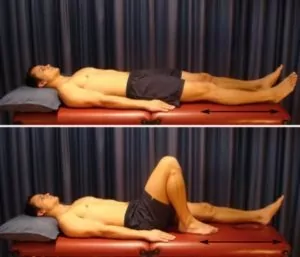
Hip Abduction
Begin this exercise lying on your back (figure 3). Keeping your knee straight, take your leg to the side as far as possible pain free, then return to the starting position. Keep your knee cap and toes facing the ceiling throughout the exercise. Repeat 10 – 20 times provided there is no increase in symptoms.
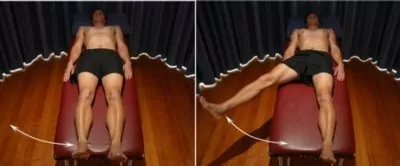
Hip External Rotation
Begin this exercise lying on your back with your knee bent and foot flat on the floor (figure 4). Take your knee to the side as far as possible pain free, then return to the starting position. Repeat 10 – 20 times provided there is no increase in symptoms.

Bridging
Begin this exercise by lying on your back in the position demonstrated (figure 5). Slowly lift your bottom pushing through your feet, until your knees, hips and shoulders are in a straight line. Tighten your bottom muscles (gluteals) as you do this and hold for 2 seconds. Then slowly return to the starting position. Repeat 10 times provided there is no increase in symptoms.
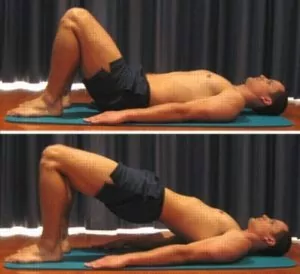
Find a Physio for a femoral neck fracture
Find a physiotherapist in your local area who can treat a femoral neck fracture.
Physiotherapy products for a femoral neck fracture
Some commonly recommended products by physiotherapists for patients with a femoral neck fracture include:
To purchase physiotherapy products for a femoral neck fracture click on one of the above links or visit the PhysioAdvisor Shop.
Other Exercises
- View Hip Stretches
- View Hip Strengthening Exercises
- View Leg Stretches
- View Leg Strengthening Exercises
- View Balance Exercises
More Information for a femoral neck fracture
- Read about Correct Footwear
- Read about How To Use Crutches correctly

Link to this Page
If you would like to link to this article on your website, simply copy the code below and add it to your page:
<a href="https://physioadvisor.com.au/injuries/hip-groin/femoral-neck-fracture”>Femoral Neck Fracture – PhysioAdvisor.com</a><br/>PhysioAdvisor offers detailed physiotherapy information on a femoral neck fracture including: diagnosis, treatment, exercises, physiotherapy products and more...
Return to the top of Femoral Neck Fracture.


